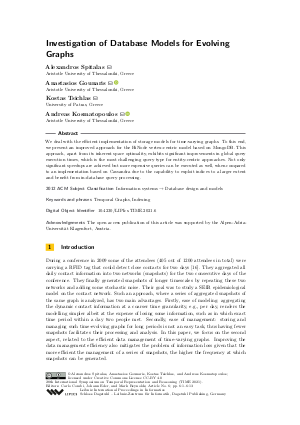Investigation of Database Models for Evolving Graphs
Authors
Alexandros Spitalas,
Anastasios Gounaris  ,
Kostas Tsichlas,
Andreas Kosmatopoulos
,
Kostas Tsichlas,
Andreas Kosmatopoulos 
-
Part of:
Volume:
28th International Symposium on Temporal Representation and Reasoning (TIME 2021)
Part of: Series: Leibniz International Proceedings in Informatics (LIPIcs)
Part of: Conference: International Symposium on Temporal Representation and Reasoning (TIME) - License:
 Creative Commons Attribution 4.0 International license
Creative Commons Attribution 4.0 International license
- Publication Date: 2021-09-16
File

PDF
LIPIcs.TIME.2021.6.pdf
- Filesize: 1.49 MB
- 13 pages
Document Identifiers
Subject Classification
ACM Subject Classification
- Information systems → Database design and models
Keywords
- Temporal Graphs
- Indexing
Metrics
- Access Statistics
-
Total Accesses (updated on a weekly basis)
0Document
0Metadata
Abstract
We deal with the efficient implementation of storage models for time-varying graphs. To this end, we present an improved approach for the HiNode vertex-centric model based on MongoDB. This approach, apart from its inherent space optimality, exhibits significant improvements in global query execution times, which is the most challenging query type for entity-centric approaches. Not only significant speedups are achieved but more expensive queries can be executed as well, when compared to an implementation based on Cassandra due to the capability to exploit indices to a larger extent and benefit from in-database query processing.
Cite As Get BibTex
Alexandros Spitalas, Anastasios Gounaris, Kostas Tsichlas, and Andreas Kosmatopoulos. Investigation of Database Models for Evolving Graphs. In 28th International Symposium on Temporal Representation and Reasoning (TIME 2021). Leibniz International Proceedings in Informatics (LIPIcs), Volume 206, pp. 6:1-6:13, Schloss Dagstuhl – Leibniz-Zentrum für Informatik (2021)
https://doi.org/10.4230/LIPIcs.TIME.2021.6
BibTex
@InProceedings{spitalas_et_al:LIPIcs.TIME.2021.6,
author = {Spitalas, Alexandros and Gounaris, Anastasios and Tsichlas, Kostas and Kosmatopoulos, Andreas},
title = {{Investigation of Database Models for Evolving Graphs}},
booktitle = {28th International Symposium on Temporal Representation and Reasoning (TIME 2021)},
pages = {6:1--6:13},
series = {Leibniz International Proceedings in Informatics (LIPIcs)},
ISBN = {978-3-95977-206-8},
ISSN = {1868-8969},
year = {2021},
volume = {206},
editor = {Combi, Carlo and Eder, Johann and Reynolds, Mark},
publisher = {Schloss Dagstuhl -- Leibniz-Zentrum f{\"u}r Informatik},
address = {Dagstuhl, Germany},
URL = {https://drops.dagstuhl.de/entities/document/10.4230/LIPIcs.TIME.2021.6},
URN = {urn:nbn:de:0030-drops-147821},
doi = {10.4230/LIPIcs.TIME.2021.6},
annote = {Keywords: Temporal Graphs, Indexing}
}
Author Details
Acknowledgements
The open access publication of this article was supported by the Alpen-Adria-Universität Klagenfurt, Austria.
Supplementary Materials
- Software (Source Code) https://github.com/alexspitalas/HiNode-MongoDB
References
-
Arnaud Casteigts, Paola Flocchini, Walter Quattrociocchi, and Nicola Santoro. Time-varying graphs and dynamic networks. International Journal of Parallel, Emergent and Distributed Systems, 27(5):387-408, 2012.

-
U. Khurana and A. Deshpande. Storing and analyzing historical graph data at scale. In EDBT, 2016.

-
Udayan Khurana and Amol Deshpande. Efficient snapshot retrieval over historical graph data. In 29th IEEE International Conference on Data Engineering, ICDE 2013, Brisbane, Australia, April 8-12, 2013, pages 997-1008, 2013.

-
Udayan Khurana and Amol Deshpande. Storing and analyzing historical graph data at scale. In EDBT, pages 77-88, 2016.

-
Andreas Kosmatopoulos, Kalliopi Giannakopoulou, Apostolos N Papadopoulos, and Kostas Tsichlas. An overview of methods for handling evolving graph sequences. In Algorithmic Aspects of Cloud Computing, pages 181-192. Springer, 2016.

- Andreas Kosmatopoulos, Anastasios Gounaris, and Kostas Tsichlas. Hinode: implementing a vertex-centric modelling approach to maintaining historical graph data. Computing, March 2019. URL: https://doi.org/10.1007/s00607-019-00715-6.
- Andreas Kosmatopoulos, Kostas Tsichlas, Anastasios Gounaris, Spyros Sioutas, and Evaggelia Pitoura. Hinode: an asymptotically space-optimal storage model for historical queries on graphs. Distributed and Parallel Databases, 2017. URL: https://doi.org/10.1007/s10619-017-7207-z.
-
Alan G. Labouseur, Jeremy Birnbaum, Paul W. Olsen, Sean R. Spillane, Jayadevan Vijayan, Jeong-Hyon Hwang, and Wook-Shin Han. The g* graph database: efficiently managing large distributed dynamic graphs. Distributed and Parallel Databases, 33(4):479-514, 2015.

-
Grzegorz Malewicz, Matthew H Austern, Aart JC Bik, James C Dehnert, Ilan Horn, Naty Leiser, and Grzegorz Czajkowski. Pregel: a system for large-scale graph processing. In Proceedings of the 2010 ACM SIGMOD International Conference on Management of data, pages 135-146. ACM, 2010.

-
Jayanta Mondal and Amol Deshpande. Managing large dynamic graphs efficiently. In Proceedings of the 2012 ACM SIGMOD International Conference on Management of Data, SIGMOD '12, pages 145-156, 2012.

-
Chenghui Ren, Eric Lo, Ben Kao, Xinjie Zhu, and Reynold Cheng. On querying historical evolving graph sequences. PVLDB, 4(11):726-737, 2011.

-
Betty Salzberg and Vassilis J Tsotras. Comparison of access methods for time-evolving data. ACM Computing Surveys (CSUR), 31(2):158-221, 1999.

-
Konstantinos Semertzidis, Evaggelia Pitoura, and Kostas Lillis. Timereach: Historical reachability queries on evolving graphs. In Proceedings of the 18th International Conference on Extending Database Technology, EDBT 2015, Brussels, Belgium, March 23-27, 2015., pages 121-132, 2015.

-
Bin Shao, Haixun Wang, and Yatao Li. Trinity: a distributed graph engine on a memory cloud. In Proceedings of the ACM SIGMOD International Conference on Management of Data, SIGMOD 2013, pages 505-516, 2013.

-
Sean R. Spillane, Jeremy Birnbaum, Daniel Bokser, Daniel Kemp, Alan G. Labouseur, Paul W. Olsen, Jayadevan Vijayan, Jeong-Hyon Hwang, and Jun-Weon Yoon. A demonstration of the G_∗ graph database system. In 29th IEEE International Conference on Data Engineering, ICDE 2013, Brisbane, Australia, April 8-12, 2013, pages 1356-1359, 2013.

-
Juliette Stehlé, Nicolas Voirin, Alain Barrat, Ciro Cattuto, Vittoria Colizza, Lorenzo Isella, Corinne Régis, Jean-François Pinton, Nagham Khanafer, Wouter Van den Broeck, and et al. Simulation of an seir infectious disease model on the dynamic contact network of conference attendees. BMC Medicine, 9(1), 2011.

-
Yajun Yang, Jeffrey Xu Yu, Hong Gao, Jian Pei, and Jianzhong Li. Mining most frequently changing component in evolving graphs. World Wide Web, 17(3):351-376, 2014.

